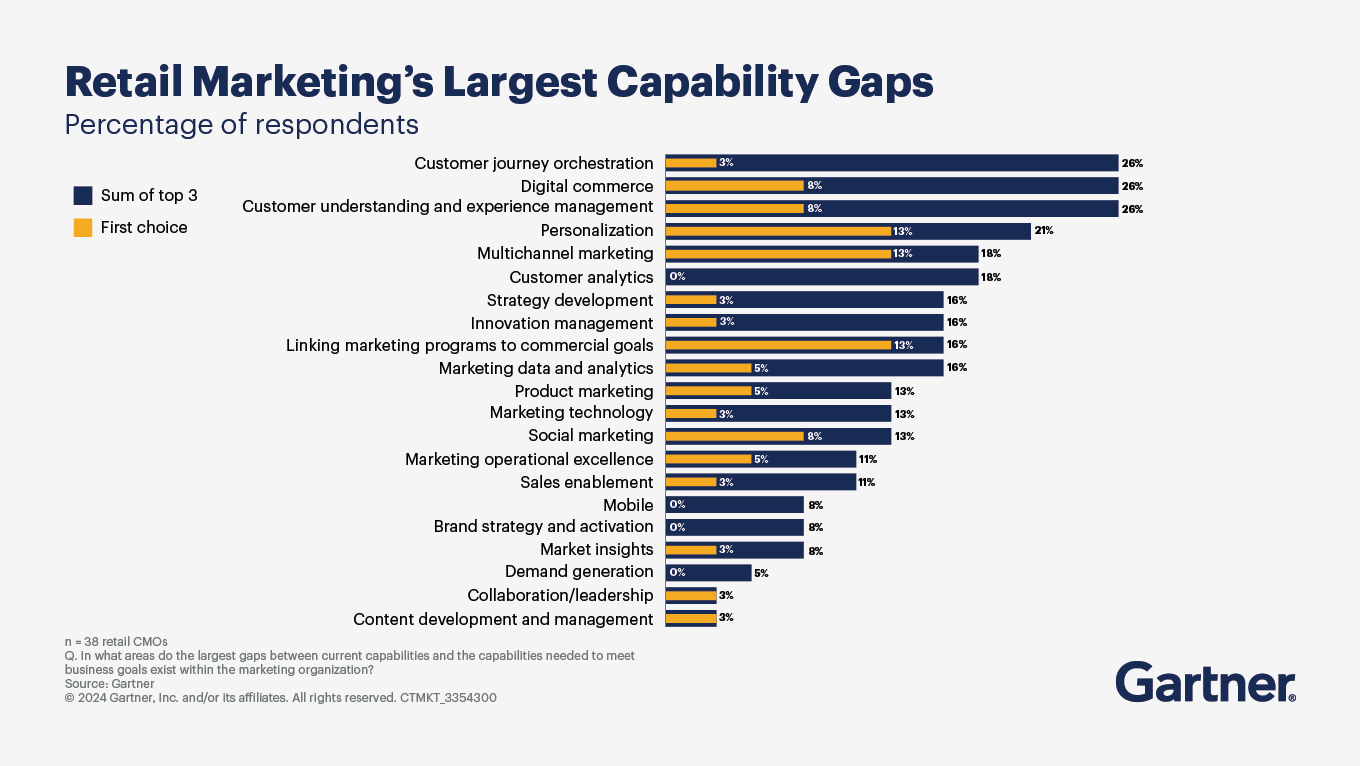By studying org structures by business model, CMOs can determine how to close skills gaps and meet their retail marketing objectives.
- Gartner client? Log in for personalized search results.
The challenges of retail marketing
Retail chief marketing officers (CMOs) want their teams to be strategic partners and thought leaders that support business growth. However, capability gaps, most notably in customer understanding and experience management, digital commerce and customer journey orchestration, can limit their ability to deliver on this goal.
With limited retail marketing budgets — only 32% of retail CMOs believe marketing has the necessary budget to successfully execute its strategy — and the percentage of marketing budgets dedicated to labor declining, CMOs may need to shake up their organizational structures to better support their ambitions.
Retail marketing: 3 types of organizational structures
Retail CMOs at luxury, multibrand and monobrand retail organizations tend to structure their organizations differently, depending on their organizational needs. Study these variances to inform how to close digital and customer experience (CX) gaps.
Luxury retail marketing structure
Luxury retail CMOs structure their organizations based on:
Geography. Luxury retail CMOs tend to prioritize revenue growth across geographies, because luxury retailers make many of their sales at physical stores and their marketing campaigns must account for cultural nuances.
Digital commerce. Luxury retail CMOs continue to refine their digital commerce initiatives, with many creating a dedicated division or hiring new leadership. Ideally, however, the entire marketing team will grow its digital skill set over time.
Center of excellence. Using a center of excellence can improve collaboration across multiple geographical locations and avoid duplicating efforts.
It’s customer-centric to focus on localizing marketing to geography, but doing so could potentially be inefficient if lessons aren’t collected and shared across geographies. Innovation can be driven by centralizing lessons learned and cascading these across the business. This may come in the form of a center of excellence. Luxury retail CMOs are still working to mature their organization’s digital commerce capabilities, with many establishing dedicated divisions within their organizational structure and expanding their digital leadership. Ideally, digital aptitude will permeate the marketing team as a whole over time versus operating in a silo.
Use customer journey data to uncover and address key points of attrition
Building a customer journey from the outside-in helps CMOs find and solve problems in the customer journey over the long term. It can also help identify quick, short-term actions to stem customer churn — allowing for immediate, demonstrable ROI.
The Buy/Own/Advocate customer journey map can help determine where to stem the highest attrition at the lowest cost:
Identify common points of churn end to end. For the “Buy” cycle, pinpoint where the most prospects fall off the path to purchase. In the “Own” cycle, focus on journey stages that cause customers to churn rather than increase brand affinity. In the “Advocate” cycle, find out where once-loyal customers fail to advance to higher levels of advocacy.
Assess the cost of churn at each touchpoint, considering lost revenue or lifetime value.
Weigh opportunities to respond by proactively addressing causes of churn and by targeting individual prospects or customers for actions designed to reengage and retain.
Multibrand retail marketing structure
Multibrand retail CMOs, meanwhile, tend to structure their teams around product- or category-specific marketing divisions, much like their merchandising counterparts do. These divisions are increasingly adding private-label marketing roles as private-label products become an important part of growth strategies.
This approach can limit long-term organizational transformation, because it focuses on the company’s needs over those of the customer. To address this, multibrand retail CMOs should ensure that product- and category-specific teams work closely with brand, communications and CX teams to prioritize the customer.
Monobrand retail marketing structure
Because digital commerce is a priority for the entire marketing org, monobrand retail organizations are unlikely to have a dedicated digital commerce team. However, they often lag in contributing to the business’s larger digital transformation strategy. When the marketing org recognizes its role in bridging this gap, they improve their contribution to the innovation and transformation of the organization at large.
Monobrand CMOs excel at focusing on and prioritizing the customer experience. Many also have dedicated brand positioning divisions to maximize brand recall and improve customer sentiment. To avoid overlap between CX and brand teams, CMOs must foster collaboration to ensure everyone makes an effective contribution to customer growth and retention.
Retail marketing FAQ
What is retail marketing?
Retail marketing involves the strategies and tactics retailers use to attract customers to their storefronts — whether physical or online — and encourage them to purchase their goods or services. The key to navigating this complex landscape is a relentless focus on strong execution and agility. The best retail marketing commands a digital audience, identifies impactful loyalty efforts and maximizes return on spend.
What are the different types of retail marketing organizations?
Retail marketing organizations can be classified into three categories:
Luxury retail. Luxury retailers cater to affluent clients with high-end products and strongly emphasize brand identity and customer service.
Multibrand retail. Multibrand retailers sell multiple brands per product category under one roof, providing customers a greater range of options.
Monobrand retail. Monobrand retailers focus on a single brand, giving them ultimate control over the brand image and customer experience.
Attend a Conference
Join Gartner experts and your peers to accelerate growth
Join CMOs and marketing executives to learn how to navigate emerging trends and challenges. From peer-led sessions to analyst one-on-ones, you'll leave ready to tackle your mission-critical priorities.
Gartner Marketing Symposium/Xpo™
Denver, CO

Drive stronger performance on your mission-critical priorities.
